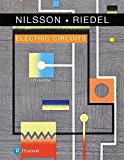
Electric Circuits Plus Mastering Engineering with Pearson eText 2.0 - Access Card Package (11th Edition) (What's New in Engineering)
11th Edition
ISBN: 9780134814117
Author: NILSSON, James W., Riedel, Susan
Publisher: PEARSON
expand_more
expand_more
format_list_bulleted
Concept explainers
Question
Chapter 6.2, Problem 3AP
(a)
To determine
Calculate the voltage
(b)
To determine
Calculate the maximum power delivered to the capacitor at any one instant of time.
(c)
To determine
Calculate the maximum energy stored in the capacitor at one instant of time.
Expert Solution & Answer
Trending nowThis is a popular solution!

Students have asked these similar questions
I need help with this problem and an explanation of the solution for the image described below. (Introduction to Signals and Systems)
I need help with this problem and an explanation of the solution for the image described below. (Introduction to Signals and Systems)
I need help with this problem and an explanation of the solution for the image described below. (Introduction to Signals and Systems)
Chapter 6 Solutions
Electric Circuits Plus Mastering Engineering with Pearson eText 2.0 - Access Card Package (11th Edition) (What's New in Engineering)
Ch. 6.1 - The current source in the circuit shown generates...Ch. 6.2 - Prob. 2APCh. 6.2 - The current in the capacitor of Assessment Problem...Ch. 6.3 - The initial values of i1 and i2 in the circuit...Ch. 6.3 - Prob. 5APCh. 6.4 - Write a set of mesh-current equations for the...Ch. 6.5 - Consider the magnetically coupled coils described...Ch. 6 - Prob. 1PCh. 6 - The voltage at the terminals of the 200 μH...Ch. 6 - The triangular current pulse shown in Fig. P6.3 is...
Ch. 6 - The current in a 200 mH inductor is
The voltage...Ch. 6 - The current in a 20 mH inductor is known to...Ch. 6 - Assume in Problem 6.5 that the value of the...Ch. 6 - Evaluate the integral
for Example 6.2. Comment on...Ch. 6 - Find the inductor current in the circuit in Fig....Ch. 6 - The current in and the voltage across a 5 H...Ch. 6 - The current in the 2.5 mH inductor in Fig. P6.11...Ch. 6 - Initially there was no energy stored in the 5 H...Ch. 6 - The voltage across a 5 μF capacitor is known to...Ch. 6 - The triangular voltage pulse shown in Fig. P6.15...Ch. 6 - The expressions for voltage, power, and energy...Ch. 6 - A 20µF capacitor is subjected to a voltage pulse...Ch. 6 - The initial voltage on the 0.5 μF capacitor shown...Ch. 6 - The current shown in Fig. P6.20 is applied to a...Ch. 6 - The rectangular-shaped current pulse shown in Fig....Ch. 6 - Use realistic inductor values from Appendix H to...Ch. 6 - For the circuit shown in Fig. P6.24, how many...Ch. 6 - The two parallel inductors in Fig. P6.26 are...Ch. 6 - Derive the equivalent circuit for a series...Ch. 6 - Derive the equivalent circuit for a parallel...Ch. 6 - Use realistic capacitor values from Appendix H to...Ch. 6 - Prob. 30PCh. 6 - The two series-connected capacitors in Fig. P6.31...Ch. 6 - The four capacitors in the circuit in Fig, P6.32...Ch. 6 - For the circuit in Fig. P6.32, calculate
the...Ch. 6 - At t = 0. a series-connected capacitor and...Ch. 6 - The current in the circuit in Fig. P6.35 is known...Ch. 6 - Show that the differential equations derived in...Ch. 6 - Prob. 37PCh. 6 - Prob. 38PCh. 6 - Let υg represent the voltage across the current...Ch. 6 - Prob. 40PCh. 6 - Prob. 41PCh. 6 - Prob. 42PCh. 6 - Prob. 43PCh. 6 - Prob. 44PCh. 6 - Prob. 45PCh. 6 - Prob. 46PCh. 6 - Prob. 47PCh. 6 - Prob. 48PCh. 6 - The self-inductances of two magnetically coupled...Ch. 6 - Prob. 50PCh. 6 - Prob. 51PCh. 6 - Prob. 52PCh. 6 - Prob. 53P
Knowledge Booster
Learn more about
Need a deep-dive on the concept behind this application? Look no further. Learn more about this topic, electrical-engineering and related others by exploring similar questions and additional content below.Similar questions
- Solve on paper not using chatgptarrow_forwardAssume that a building manager instructed you to install a water heater. The specs on the water heater nameplate reveals the following 240V, 2PH, 60HZ, 5.7KW. The manager insisted for the installation to be done with 10 AWG copper THWN-2 conductor, the length of run is 1200 FT away from the service panel. Calculate the voltage after the installation.arrow_forwardPlease confirm that my solution is correct, especially the block diagram. Please DRAW (not type) what the block diagram would look like if it's incorrect. thank youarrow_forward
arrow_back_ios
SEE MORE QUESTIONS
arrow_forward_ios
Recommended textbooks for you
 Introductory Circuit Analysis (13th Edition)Electrical EngineeringISBN:9780133923605Author:Robert L. BoylestadPublisher:PEARSON
Introductory Circuit Analysis (13th Edition)Electrical EngineeringISBN:9780133923605Author:Robert L. BoylestadPublisher:PEARSON Delmar's Standard Textbook Of ElectricityElectrical EngineeringISBN:9781337900348Author:Stephen L. HermanPublisher:Cengage Learning
Delmar's Standard Textbook Of ElectricityElectrical EngineeringISBN:9781337900348Author:Stephen L. HermanPublisher:Cengage Learning Programmable Logic ControllersElectrical EngineeringISBN:9780073373843Author:Frank D. PetruzellaPublisher:McGraw-Hill Education
Programmable Logic ControllersElectrical EngineeringISBN:9780073373843Author:Frank D. PetruzellaPublisher:McGraw-Hill Education Fundamentals of Electric CircuitsElectrical EngineeringISBN:9780078028229Author:Charles K Alexander, Matthew SadikuPublisher:McGraw-Hill Education
Fundamentals of Electric CircuitsElectrical EngineeringISBN:9780078028229Author:Charles K Alexander, Matthew SadikuPublisher:McGraw-Hill Education Electric Circuits. (11th Edition)Electrical EngineeringISBN:9780134746968Author:James W. Nilsson, Susan RiedelPublisher:PEARSON
Electric Circuits. (11th Edition)Electrical EngineeringISBN:9780134746968Author:James W. Nilsson, Susan RiedelPublisher:PEARSON Engineering ElectromagneticsElectrical EngineeringISBN:9780078028151Author:Hayt, William H. (william Hart), Jr, BUCK, John A.Publisher:Mcgraw-hill Education,
Engineering ElectromagneticsElectrical EngineeringISBN:9780078028151Author:Hayt, William H. (william Hart), Jr, BUCK, John A.Publisher:Mcgraw-hill Education,

Introductory Circuit Analysis (13th Edition)
Electrical Engineering
ISBN:9780133923605
Author:Robert L. Boylestad
Publisher:PEARSON

Delmar's Standard Textbook Of Electricity
Electrical Engineering
ISBN:9781337900348
Author:Stephen L. Herman
Publisher:Cengage Learning

Programmable Logic Controllers
Electrical Engineering
ISBN:9780073373843
Author:Frank D. Petruzella
Publisher:McGraw-Hill Education

Fundamentals of Electric Circuits
Electrical Engineering
ISBN:9780078028229
Author:Charles K Alexander, Matthew Sadiku
Publisher:McGraw-Hill Education

Electric Circuits. (11th Edition)
Electrical Engineering
ISBN:9780134746968
Author:James W. Nilsson, Susan Riedel
Publisher:PEARSON

Engineering Electromagnetics
Electrical Engineering
ISBN:9780078028151
Author:Hayt, William H. (william Hart), Jr, BUCK, John A.
Publisher:Mcgraw-hill Education,
Capacitors Explained - The basics how capacitors work working principle; Author: The Engineering Mindset;https://www.youtube.com/watch?v=X4EUwTwZ110;License: Standard YouTube License, CC-BY